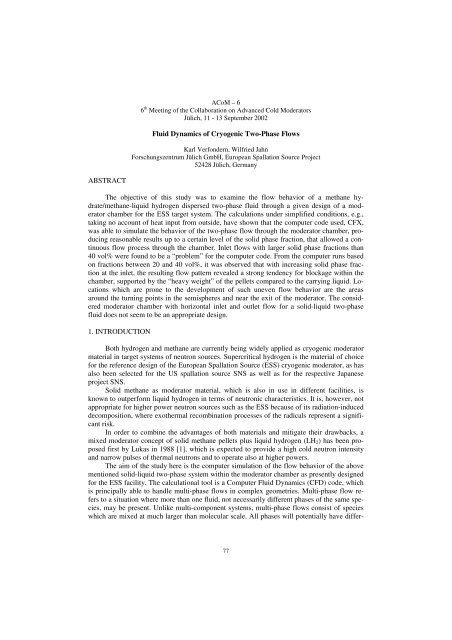Druck-Materie 20b.qxd - JUWEL - Forschungszentrum Jülich
Druck-Materie 20b.qxd - JUWEL - Forschungszentrum Jülich
Druck-Materie 20b.qxd - JUWEL - Forschungszentrum Jülich
You also want an ePaper? Increase the reach of your titles
YUMPU automatically turns print PDFs into web optimized ePapers that Google loves.
ABSTRACT<br />
ACoM – 6<br />
6 th Meeting of the Collaboration on Advanced Cold Moderators<br />
<strong>Jülich</strong>, 11 - 13 September 2002<br />
Fluid Dynamics of Cryogenic Two-Phase Flows<br />
Karl Verfondern, Wilfried Jahn<br />
<strong>Forschungszentrum</strong> <strong>Jülich</strong> GmbH, European Spallation Source Project<br />
52428 <strong>Jülich</strong>, Germany<br />
The objective of this study was to examine the flow behavior of a methane hydrate/methane-liquid<br />
hydrogen dispersed two-phase fluid through a given design of a moderator<br />
chamber for the ESS target system. The calculations under simplified conditions, e.g.,<br />
taking no account of heat input from outside, have shown that the computer code used, CFX,<br />
was able to simulate the behavior of the two-phase flow through the moderator chamber, producing<br />
reasonable results up to a certain level of the solid phase fraction, that allowed a continuous<br />
flow process through the chamber. Inlet flows with larger solid phase fractions than<br />
40 vol% were found to be a “problem” for the computer code. From the computer runs based<br />
on fractions between 20 and 40 vol%, it was observed that with increasing solid phase fraction<br />
at the inlet, the resulting flow pattern revealed a strong tendency for blockage within the<br />
chamber, supported by the “heavy weight” of the pellets compared to the carrying liquid. Locations<br />
which are prone to the development of such uneven flow behavior are the areas<br />
around the turning points in the semispheres and near the exit of the moderator. The considered<br />
moderator chamber with horizontal inlet and outlet flow for a solid-liquid two-phase<br />
fluid does not seem to be an appropriate design.<br />
1. INTRODUCTION<br />
Both hydrogen and methane are currently being widely applied as cryogenic moderator<br />
material in target systems of neutron sources. Supercritical hydrogen is the material of choice<br />
for the reference design of the European Spallation Source (ESS) cryogenic moderator, as has<br />
also been selected for the US spallation source SNS as well as for the respective Japanese<br />
project SNS.<br />
Solid methane as moderator material, which is also in use in different facilities, is<br />
known to outperform liquid hydrogen in terms of neutronic characteristics. It is, however, not<br />
appropriate for higher power neutron sources such as the ESS because of its radiation-induced<br />
decomposition, where exothermal recombination processes of the radicals represent a significant<br />
risk.<br />
In order to combine the advantages of both materials and mitigate their drawbacks, a<br />
mixed moderator concept of solid methane pellets plus liquid hydrogen (LH2) has been proposed<br />
first by Lukas in 1988 [1], which is expected to provide a high cold neutron intensity<br />
and narrow pulses of thermal neutrons and to operate also at higher powers.<br />
The aim of the study here is the computer simulation of the flow behavior of the above<br />
mentioned solid-liquid two-phase system within the moderator chamber as presently designed<br />
for the ESS facility. The calculational tool is a Computer Fluid Dynamics (CFD) code, which<br />
is principally able to handle multi-phase flows in complex geometries. Multi-phase flow refers<br />
to a situation where more than one fluid, not necessarily different phases of the same species,<br />
may be present. Unlike multi-component systems, multi-phase flows consist of species<br />
which are mixed at much larger than molecular scale. All phases will potentially have differ-<br />
77

















